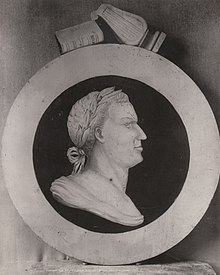Christian Frederik Hagerup
Christian Frederik Hagerup (born July 31, 1731 in Trondheim , † June 30, 1797 in Trondheim) was a Norwegian pastor.
His parents were Bishop Eiler Hagerup the Elder and his wife Anne Cathrine Barhow († 1737). On September 20, 1764, he married Anne Margrethe Cathrine Westermann (1736 - July 15, 1819), daughter of the weighing master and calibration officer, Chamber Councilor Bernt Westermann (1695–1765) and his wife Esther Høyer (1707–1776).
Hagerup grew up in Trondheim, where his father was appointed bishop shortly before he was born. In 1749 he graduated from Latin school in Trondheim and then studied theology in Copenhagen. Theologically, Hagerub was orthodox and conservative. After graduating in 1752, he studied languages and returned to Trondheim in 1755. In 1758 he was sent as a missionary to the Sami in Skjerstad (now Bodø ) and Saltdal . In 1761 he became deputy pastor in Skjerstad and in 1768 provost in the provost's office in Salten . At that time Skjerstad was subordinate to the pastor in Bodø, Titular Bishop Nicolaus Christian Friis , but the provost in Salten was his superior. In this capacity, Hagerup initiated an investigation into Friis in the 1960s for irregularities in the use of the missions quorum's funds, which ultimately cost them the office. During this time he devoted himself to the study of astronomy and collected extensive botanical material, which was later made available to Bishop Johan Ernst Gunnerus , and introduced the potato in Skjerstad .
In 1769 Hagerup became pastor in the Vår Frue kirke (Church of Our Lady) in Trondheim and in 1772 Notarius capituli at the cathedral chapter. When Marcus Fredrik Bang became bishop in Trondheim and Bang's son-in-law and opponent of Hagerup Ole Irgens provost of the diocese, he evaded to Bergen , where he became pastor at the Nykirke. But when Irgens became bishop in Bergen in 1780, he returned to Trondheim. There he became provost of the diocese and pastor at the cathedral church. In Trondheim he campaigned for the establishment of a secondary school and was in its management until 1791.
He enjoyed a great reputation as a proper administrator of his parish, an able clergyman and a good preacher. In 1773 he became a master of theology and in 1779 earned his doctorate in Copenhagen.
He was also involved in public life. In Bergen he was co-founder of Det nyttige Selskab (The Useful Society) and as a member of the board of De frivillige Harmonisters Academie (the later music society Harmonia ). In 1768 he became a member of Det Kongelige Norske Videnskabers Selskab in Trondheim and was deputy chairman of this society from 1780 to 1791. He was also a member of the Natural Research Society in Gdansk and the Topographical Society in Christiania. He became known for his commitment to scientific research, pedagogy and for founding a Norwegian university. His speech to Det Kongelige Norske Videnskabers Selskab on July 14, 1788 in the presence of Crown Prince Friedrich was particularly impressive . He also worked intensively for the better education of the Sami and supported their school attendance from his own resources and created a solid basis for the knowledge of the Sami language.
Works (selection)
- Dissertatio theologica fiduciam fidelium Christo resuscitato nixam exhibens , Dissertation Copenhagen 1779
- Tale holden i det Kgl. Norske Videnskabers Selskab i Tronhiem on July 14, 1788 . In: Minerva 1789, Part 2, pp. 204-221
- Beskrivelse af Motacilla acredula . in: Det Kongelige Norske Videnskabers Selskab , special print, Latest Collection, Vol. 1, 1798, pp. 101-108
Remarks
- ↑ Notarius capituli was the secretary of the cathedral chapter. He kept the minutes and copy books of the cathedral chapter.
- ^ "The Useful Society" was founded in Bergen in 1774 and is one of the oldest associations in Norway. Its aims were to promote industry, general education, agriculture and fishing. It was a typical product of the Age of Enlightenment in Norway.
- ↑ Today's scientific name "Phylloscopus trochilus"
literature
- Arne Bugge Amundsen: Christian Frederik Hagerup . In: Norsk biografisk leksikon , accessed on March 23, 2010.
| personal data | |
|---|---|
| SURNAME | Hagerup, Christian Frederik |
| BRIEF DESCRIPTION | Norwegian pastor |
| DATE OF BIRTH | July 31, 1731 |
| PLACE OF BIRTH | Trondheim |
| DATE OF DEATH | June 30, 1797 |
| Place of death | Trondheim |
